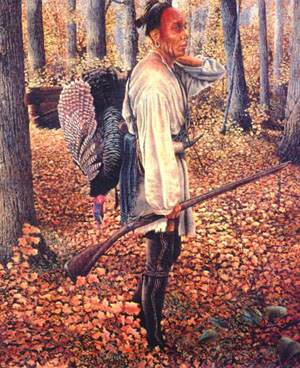Susquehannocks
 |
Little is known about Pennsylvania’s first human occupants. As early as 7000 BC, when the great Wisconsin glacier covered New York State, Pennsylvania was covered with arctic plants and spruce-fir forests. Mastodon, musk ox and caribou grazed the Susquehanna River Valley and undoubtedly provided food for its human inhabitants. Known to archeologists as the Paleo-Indians, we can only speculate what their physical appearance, language, religion, and social activity was like, by studying the tools they used. It seems that roughly around the time of Christ these hunters and gatherers moved northward, in response to the retreating glacier.
The earliest human life to be acknowledged in any written record of the Susquehanna Valley was the Susquehannock Indians. The Susquehannocks identified themselves as a branch of the Andastes, which were a subdivision of the larger Algonquin family. During the sixteenth century and carrying forward into the years of colonization the Susquehannocks were the most numerous people in the Susquehanna Valley; in fact it is estimated that their population exceeded six thousand in the 1640’s. However, as their northern neighbors, the New York Iroquois, gained power and prestige, the Susquehannocks experienced pressure to migrate southward until eventually in 1675, when devastated with disease and devoid of any European allies, they became annihilated by the Iroquois. A small portion of the survivors fled to a reservation on the Conestoga Creek (in the present day Lancaster area), but the majority were absorbed into the Iroquoian people. By 1763 the Andastes were extinct.
When John Smith arrived in 1608 he described them as wearing bear and wolf skins, and carrying bows, arrows and clubs. In their most typical form, the Susquehannocks were farmers who grew large crops of corn, beans and squash along the fertile flood plains of the river. They also worked as gatherers and hunters, collecting wild-plant foods, seeds, nuts, insects, reptiles, mollusks, fish, birds, and mammals. They lived in fortified cities, which were composed of sixty to eighty foot long, bark-covered longhouses. Several families lived in each long house, but all were related to one another via matrilineal lines of descent. In fact, like many Native Americans, the Susquehannock social organization was centered almost entirely about female ancestry. Those Susquehannocks who signed various treaties with the whites, particularly those with the Maryland colony, recorded their nation or family affiliations as descending from their mother and her female ancestors.
The Susquehannocks established their towns along the branches of the Susquehanna because the waters facilitated travel and trade in the region and allowed the Indians to use fish as a dietary supplement. It should also be noted that the word Susquehannock was not what the Native Americans called themselves. It is difficult to know what they called themselves, but we do know that the term Susquehannock was the Algonquian word used for them by the English during the seventeenth century. They were known as the Minqua by the Dutch and the Swedes, the Andaste by the French, and after 1700 became increasingly referred to as the Conestoga.
After the Susquehannocks left the area the Delaware and Shawnee Indians migrated from Philadelphia and, while subject to the Iroquois Confederacy established Shamokin in 1724.